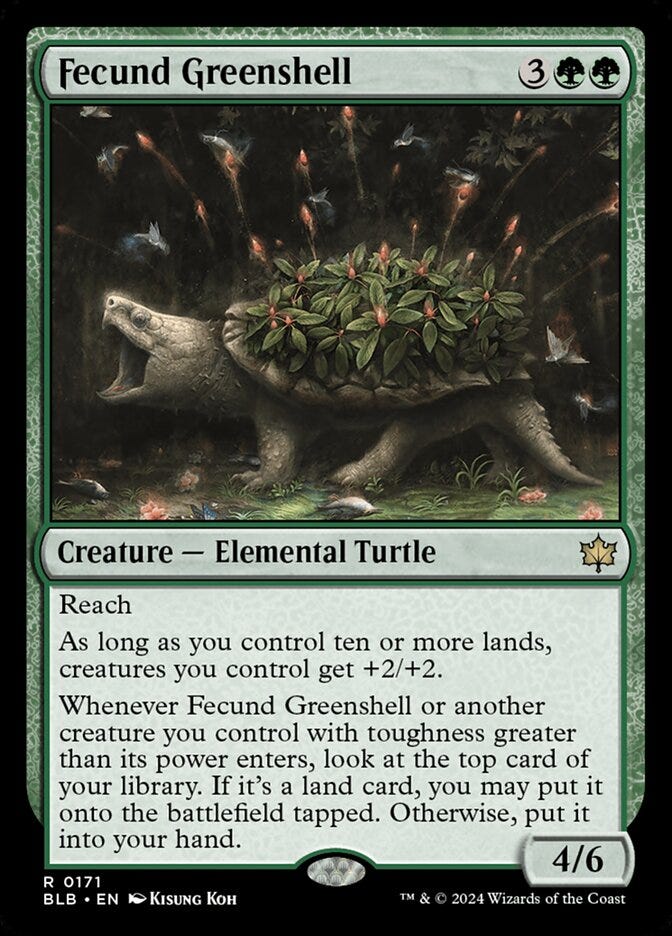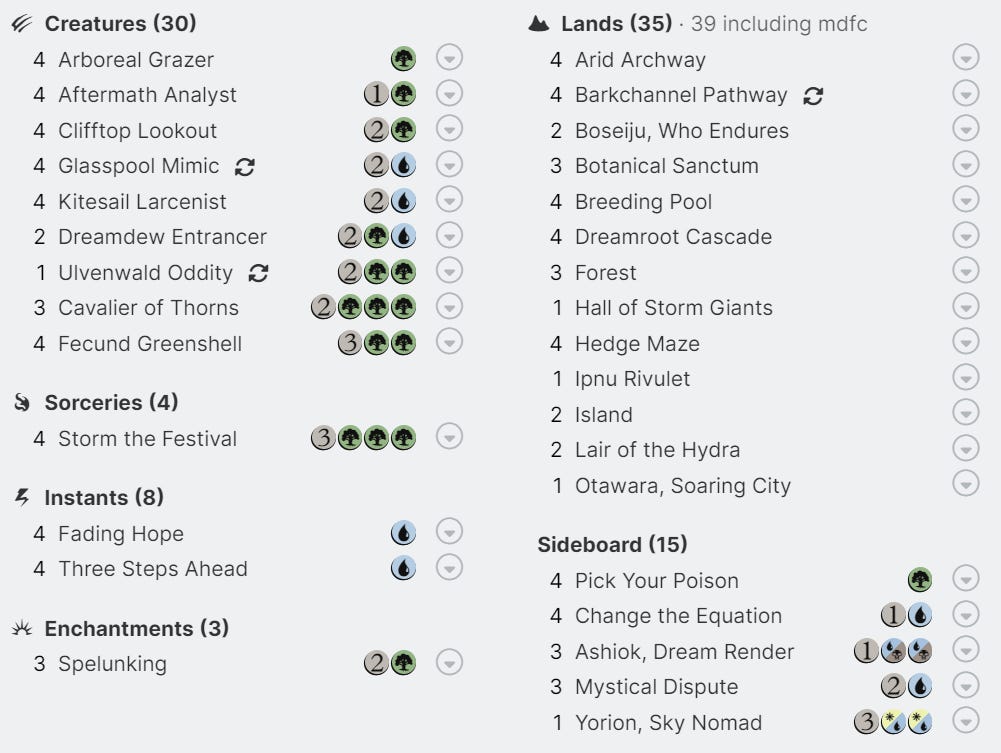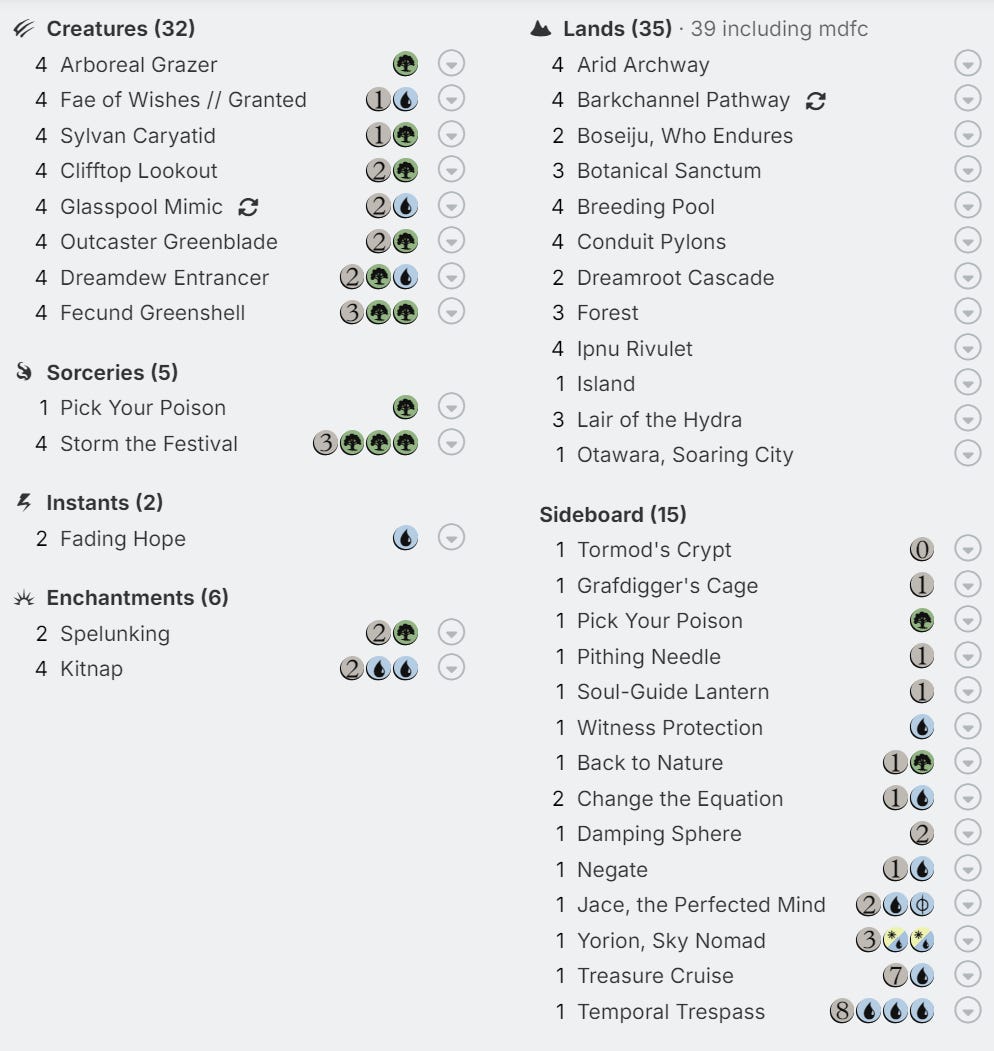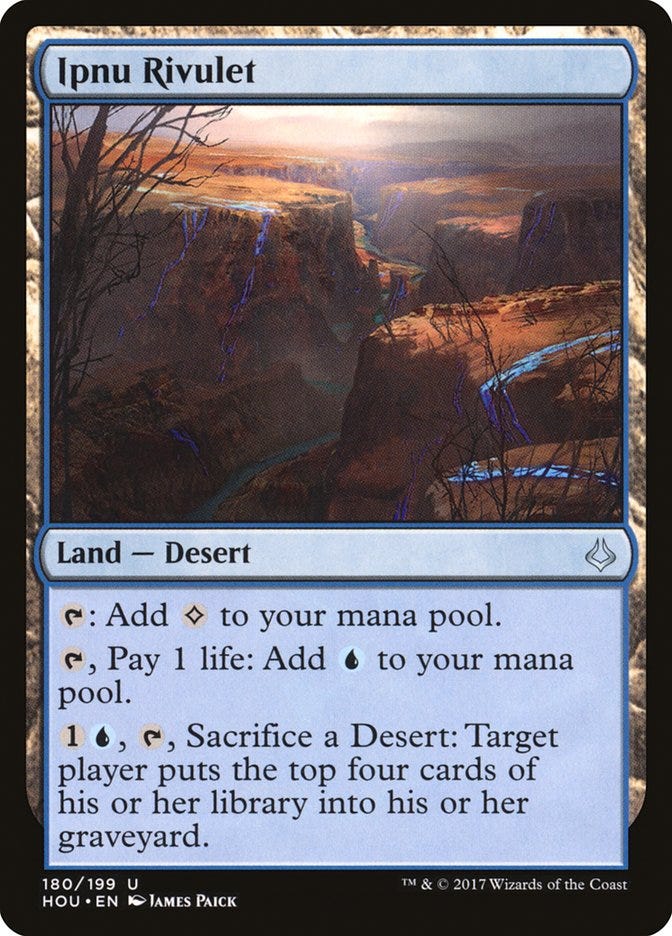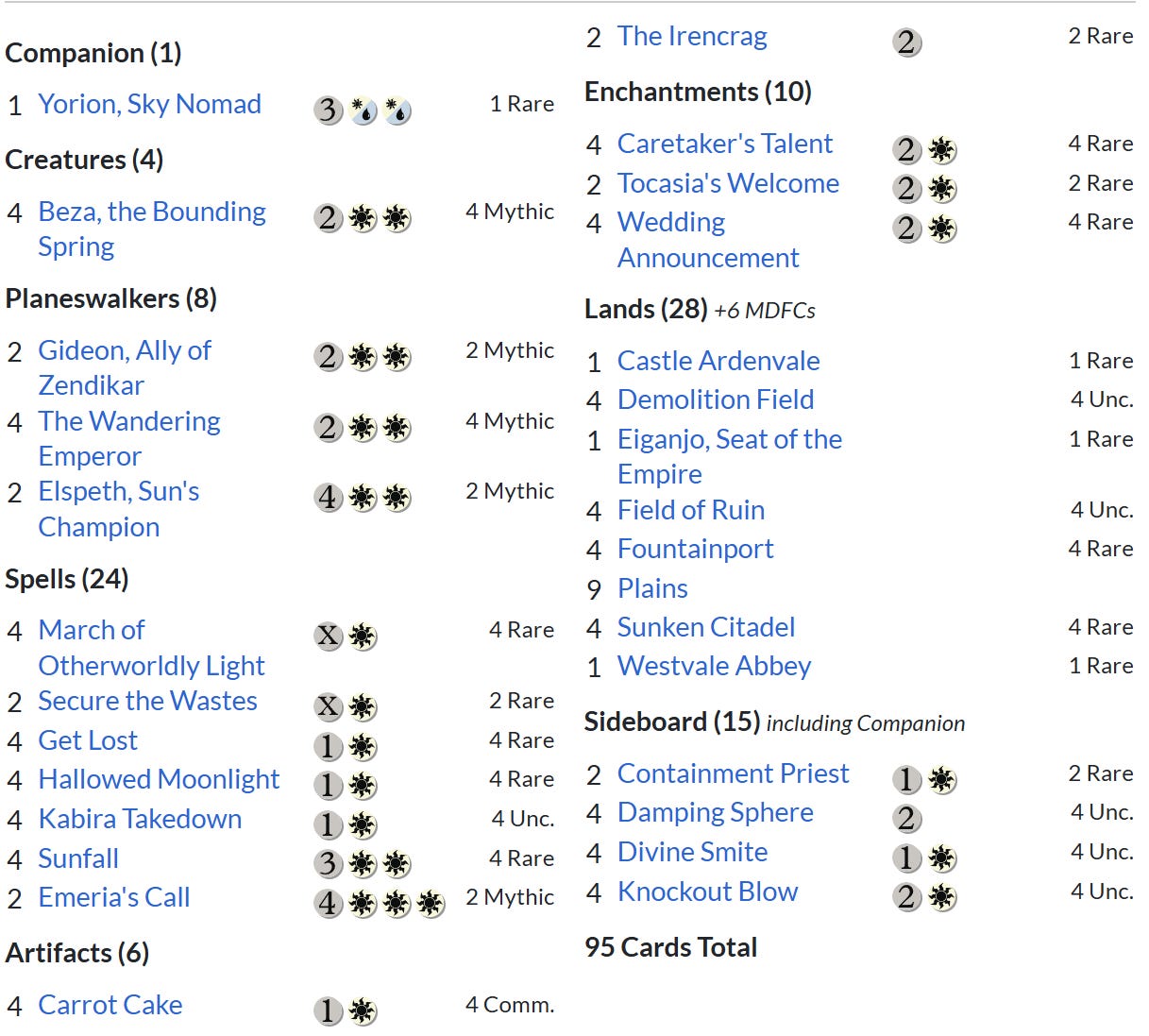I have been working on a Simic Fecund Greenshell list that I think is quite strong. I took it into a challenge recently and relatively comfortably made it to Top 8.
I lost the first round of the Top 8, but I was fading and playing poorly at that point, while my opponent played excellently, so good chance that loss has as much to say about relative play skill at that point than the quality of the deck.
The Deck’s Evolution
This list’s origins are from the Greenshell Ramp list I discuss in this article.
This was the first deck I played when BLB came out. I went 3-2 with it. Greenshell felt powerful, but overall the deck didn’t feel great so I put it and Greenshell brewing on pause for a bit.
But then after the set was out for a week I did my usual checking of 17Lands stats to see if there were any cards that jump out (a brewing trick I learned from Faithless Brewing’s Cavedan).
Fecund Greenshell obviously stands out as being quite high in these stats. But what stood out to me even more was that Dreamdew Entrancer was ranked second of the Pioneer legal cards. This stood out in particular to me because I had been disappointed with Dreamdew in my initial deck.
This is a good example of the power of using 17Lands as a brewer. It provided counter evidence to my experience, which pushed me to check my assumptions and give Dreamdew another chance. The exact same thing happened to me with Bloodtithe Harvester awhile back and led to me putting Bloodtithe Harvester on the map in Pioneer.
These 17Lands stats combined with another brewer in the Faithless Brewing Discord working on their own Simic Greenshell lists inspired me to get back to Greenshell brewing. My focus this time was going to be on maximizing Dreamdew Entrancer in addition to the turtle.
The Deck
After a few iterations, this is the list I ended up taking into the Challenge.
Decklist Link
On the maximizing Dreamdew Entrancer front, it plays better as a four of because if you stun your own creature for the card draw on Dreamdew, you can then use that creature as the target for subsequent Dreamdew stuns.
Kitnap similarly synergizes well with Dreamdew where you steal their creature and put stun counters on it. Then you use that as your body for future Dreamdew stun+draw targets.
I will frequently end up with 5 stun counters on a creature I control. Usually a Grazer, a Canopy Lookout, or a creature I’ve Kitnapped.
In the list you also can see there are also a number of ideas here from my desert brewing. I got the Fae of Wishes version discussed in that article to a very strong state heading into BLB’s release.
What makes this deck strong
What makes this deck so strong is how aggressively it goes after the top decks in the format.
Rakdos Vampires- Vampires is strong because it attacks on two axis: the traditional grind them out Rakdos midrange and the ability to go over the top with Vein Ripper.
For fighting the grind them out plan, my deck just has way more value, especially with the Arid Archways which act like a land with a draw card ETB. Classically ramp decks are good against the grindy low resource Rakdos midrange style decks and this is no exception.
Against the Vein Ripper plan, I have access to effectively 5 copies of maindeck Pick Your Poison.
Even more powerful, I run 4 copies of Kitnap with plenty of creatures I have no problem sacing to Vein Ripper’s ward like Arboreal Grazer and Clifftop Lookout. When they Sorin in a Vein Ripper and then you sacrifice your Grazer or Clifftop to Kitnap it that’s effectively a 3 for 1 that they are not coming back from.
You can even do the move where you flicker Kitnap with Yorion and attach it to a Vein Ripper getting around the Ward.
And then I have Reach chump blockers and card selection from my lands that can give me the time and selection to draw into answers.
Here is an example of what the games look like with both decks doing their thing, this list just goes bigger even in the face of multiple Vein Rippers.
Abzan Amalia- My deck also operates as a mill deck thanks to the 4 Ipnu Rivulets, 8 additional deserts, and multiple ways to dig for them. Amalia conveniently when it combos mills most of its deck for you.
A line I planned for when designing this deck: they combo, going through most of their deck and leaving Aetherflux Reservoir on top. Then I Ipnu Rivulet them, milling the Reservoir, and then I play Dreamdew tapping down and stunning the Amalia. Then on my next turn I mill out the rest of their deck with multiple Ipnu Rivulets.
That seems like a fairly specific line, but it played out in my first match against Amalia and is more reliable to orchestrate than you would think.
The key part of that interaction is that what makes Amalia so strong and consistent is they can control the top of their deck. With Ipnu Rivulets you remove that ability and then Amalia becomes a far less consistent combo deck full of small creatures and limited card advantage. That’s not a free win, but is far less threatening.
Izzet Phoenix- The key creatures in my deck are a 3/4 Reach and a 4/6 Reach, stat lines that line up great against Phoenix’s removal, which does 3 damage and 5 damage, and also lines up well for blocking Arclight Phoenix.
In addition, there is Fae of Wishes a 1/4 flying which blocks well for two mana, and Grazer and Clifftop Lookout which both have Reach and can operate as good chump blockers.
And eventually when you get to 10 lands in play with a Greenshell in play, Phoenix is basically unable to deal with any of your creatures.
So it is tough for Phoenix to get the kill and then like with Amalia, Phoenix empties its deck on its own, so it is relatively easy to mill them out with Ipnu Rivulets.
My blocking plan did run into some issues against Proft’s Eidetic Memory, Fae of Wishes in particular underperformed, so I will be experimenting with cutting Fae in future versions for more Fading Hopes and Spelunkings.
Competitive brewing is about hard targeting the meta
I find brewing far easier in metas like the current one, where there is a well defined meta with clear top decks.
I kind of feel this blog has recently turned into a Simic brewing blog. I've been testing other decks, but the ones I've really explored enough to want to write about have been Simic.
But what's really going on is this is a blog about competitive brewing in Pioneer. Three of the top 5 decks in the format essentially mill themselves out: Amalia, Phoenix, and UW Control. Given that, I have identified that Ipnu Rivulet is a particularly well positioned card (and while it may look like a Blue card, it is really a Simic card because it wants to be paired with ramp).
As a general rule, I do not try and brew generically powerful decks, I brew decks designed to exploit weaknesses in the top decks in the format and this focus on Simic is a clear example of this in practice.
I think a good way to approach brewing is looking at the format’s top decks and ask yourself how do I crush them. If your brew does not crush, two of the top three decks that should be a sign to move on to trying something different.
In this challenge I faced Vampires 4 times, Phoenix twice, and Niv once. When I won the Super Qualifier back during Inverter period I was running a deck that had a 90% winrate against Inverter and I faced it 6 times in that Qualifier. That deck also had a 100% winrate against Sultai the number two deck at the time.
When you have great winrates against the decks you are going to see multiple times in a tournament it’s like you are entering the tournament with several byes.
Focusing on hard targeting the top decks also helps narrow your focus. There are a ton of cards in Pioneer and a ton of potentially good decks. So where should you focus your brewing efforts. Narrow it down to things you know the top decks struggle with.
For example:
Phoenix and Vampires rely on one for one removal, so are vulnerable to cards that create multiple bodies
Amalia has one basic, so its vulnerable to Field of Ruin and Demolition Field
All three rely on creatures entering without being cast, so vulnerable to effects that turn that off
All three can be out valued if you are able to fend off their angles of attack
Exile removal is at a premium against all three
And you see Tulio_Jaudy exploiting all these points with their awesome Mono-W Tokens Control brew that won a recent challenge.
Decklist Link
As a brewer, you always want to be the one to break a format and get a card banned. But in a well defined meta you are better served by not worrying about breaking the format and instead focusing your brewing on crushing the top decks.

